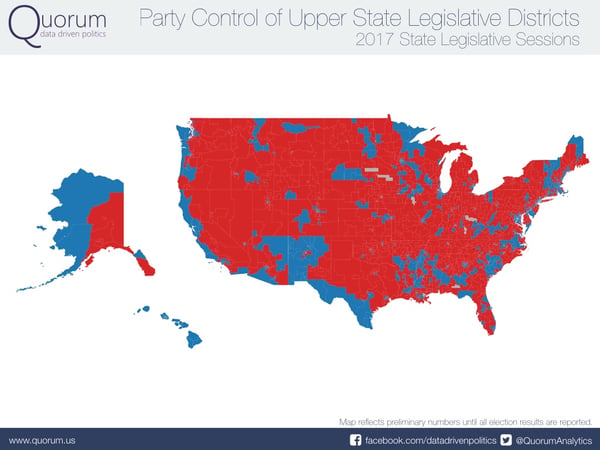With Congress in intense partisan gridlock over the last few years, the influence of state legislatures has grown. Going into 2023, that influence will only get stronger as we see a historically narrow majority for Republicans in the House, likely inhibiting substantial legislation from leaving the chamber. In just the past year, we’ve seen state legislatures gain sway in issues due to Supreme Court decisions, such as access to abortions following the Dobbs decision by the Supreme Court.
How did the 2022 midterms impact state legislative control?
Republicans continue to control a greater number of legislatures with majorities in 57 chambers
Republicans have dominated state legislatures for the past decade, and that trend continues to be true now. While they went into the election with control of 61 chambers and came out of the night with control of 56, they still outnumber Democratic-controlled chambers. Overall, Republicans hold full control of 22 states (a shift from 23 prior to the 2022 midterms as the Pennsylvania House flipped to blue).
Democrats gained ground in the 2022 elections, flipping four chambers
With the four flips, Democrats control 40 state legislative chambers to the Republicans’ 56 (Nebraska’s legislature is unicameral and nonpartisan). Democrats gained new majorities in the Michigan House, Michigan Senate, Minnesota House, and Pennsylvania House. Four flipped chambers is low for an election year. According to the National Conference of State Legislatures, an average of 12 chambers have flipped each two-year cycle over the last 120 years.
Half of all states are likely to have veto-proof majorities in the legislature
Not only will there be less divided government in states (with divided control defined as states where one of the power positions is controlled by one party and the other two by the other party), half of all state legislatures are likely to have veto-proof majorities (also known as supermajorities). Prior to the election, 15 Republican states and six Democratic states held veto-proof majorities. Now, Republicans hold supermajorities in 17 states and Democrats in nine.
State Legislatures by Party
Originally published November 21, 2016
Last week the Republican Party established a federal trifecta and with wins in the Minnesota Senate, Kentucky House, and Iowa Senate, the GOP now controls both state legislative chambers in 32 states. According to The National Conference of State Legislatures, Republicans now control more state legislatures than at any point in U.S. history. However, they have yet to beat out Democrats’ 1975 record of complete control in 37 state legislatures.
Republicans now control 34 upper chambers, while Democrats control 13.
While Republicans gained control of the Iowa Senate and Minnesota Senate, they lost previous control of the Nevada Senate. The Democratic Party numerically gained control of the Washington Senate; however, State Sen. Tim Sheldon (D-WA-35) will caucus with the Republican Party, giving Republicans control of the chamber. The Connecticut Senate is now split after all 36 State Senators were up for reelection and Republicans were able to flip three seats. Yet, Democrats will maintain majority vote and state trifecta status with Democratic Lt. Governor Nancy Wyman as the Senate’s tie breaker.

Democrats gained control of two lower chambers, bringing their total count to 17, but Republicans still control 31 lower state chambers.
Democratic legislators took majority in the New Mexico House and the Nevada Assembly, turning the Nevada state legislature completely blue. Additionally, while numerically Republicans hold majority in the Alaska House, coalition governing will give Democrats the vote majority. Republicans won a majority in the Kentucky House for the first time since 1920, picking up 17 seats.

In total, Republicans will control 4,170 state legislative seats and both chambers in 32 state legislatures. Meanwhile Democrats will control 3,129 individual seats and both chambers in 13 legislatures. Maine and Colorado are the only state legislatures where there remains a split in control.
While the Republican Party’s control is significant, these numbers are not drastically different from the GOP’s control during the 2016 state legislative session. Data found using Quorum States.
Learn how you can stay up to date, engaged and active in our democracy with Quorum’s public affairs software.
